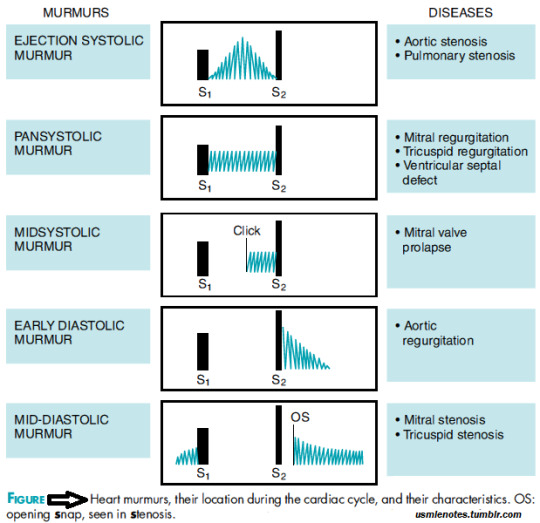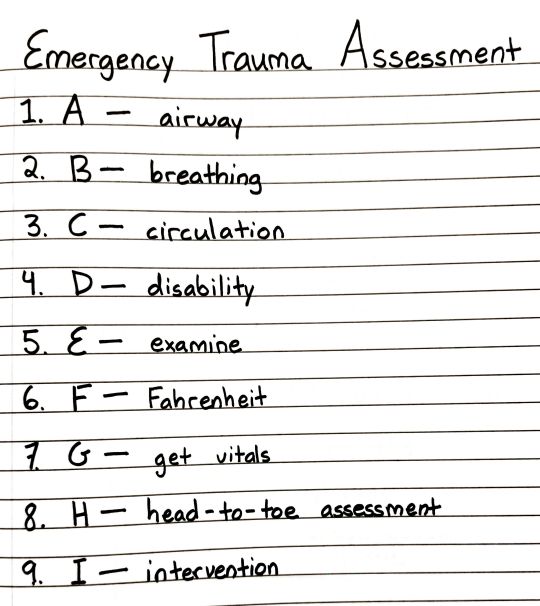Text
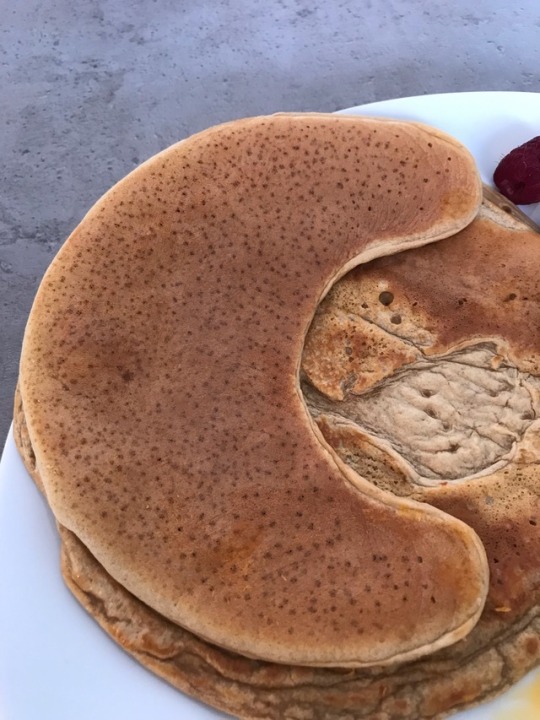
Perfectly C-formed Duodenum-Pancake 💪🏽
0 notes
Text
Osmosis: Sleep Apnea
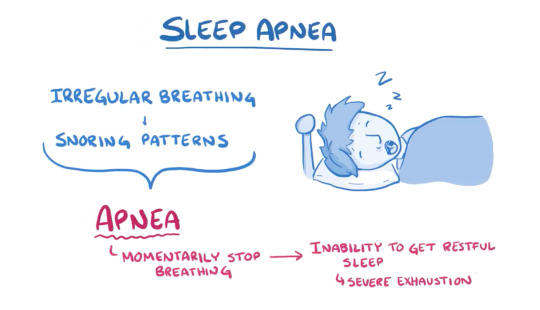
Sleep apnea is a sleep disorder which causes irregular breathing and snoring patterns that can ultimately cause apnea, which is where a person momentarily stops breathing altogether. The inability to get restful sleep can also lead to severe exhaustion.
Individuals can have obstructive sleep apnea, central sleep apnea, or features of both.
Obstructive sleep apnea is the most common form, and it develops when there’s a blockage of the airways. Air has to go form the nose through the nasopharynx into the laryngopharynx, through the larynx and then into the trachea. Somewhere along that path, there might be a blockage in the flow of air.
Allergies might cause swelling of the tissue in the nasopharynx,
or there might be swollen adenoid glands or tonsils because of an infection.
There might be a severe underbite which pulls the jaw back and blocks the airway.
In individuals that are overweight, there could be too much weight in the soft tissues of the neck, which can weigh down the airway especially when a person is lying down.
These problems are most obvious at night because hormonal changes at night cause the muscles around the airway to becomes slightly less stiff while sleeping. This means that they are less able to keep the airway open, making it more likely to get a bit squashed or obstructed.
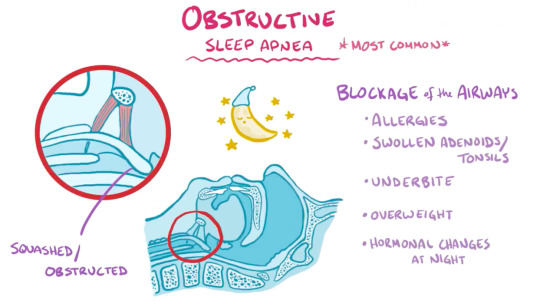
Central sleep apnea refers to the fact that the problem is “central” or related to the central nervous system. This is where the brain intermittently stops making an effort to breathe for 10 to 30 seconds. The apnea can persist for several seconds even after waking up, triggering feelings of panic and futher disrupting the sleep cycle.
Central sleep apnea starts with an initial episode of hyperpnea, which is when the brain directs the lungs to start hyperventilating during sleep by increasing the respiratory rate. This rapid breathing causes hypocapnia, a drop in the blood’s carbon dioxide levels. When the carbon dioxide falls below a certain threshold, the body slips into a state of apnea, making no effort to breathe and taking in no oxygen. This causes the carbon dioxide levels to rise back to normal levels and then, as the apnea persist, they keep rising to which is called hypercapnia. The really high carbon dioxide levels triggers hyperpnea again, and the cycle starts all over. Essentially, the respiratory system is going rapidly back and forth between two states, first making no effort to breathe and then hyperventilating, with no in-between.
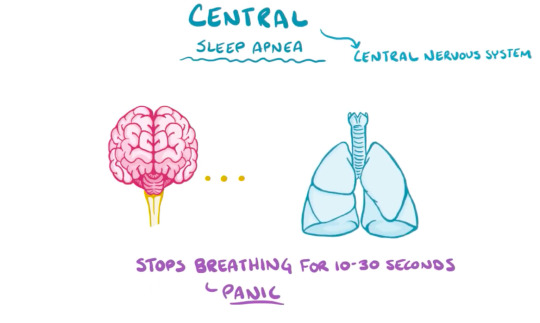
Via Osmosis
16 notes
·
View notes
Text

This sketch is freaking awesome!
Thyroid basics!
596 notes
·
View notes
Text
If you’re thinking about studying medicine, read this.

Remember that it’s hard for everyone and no one woke up one day knowing it all.
Don’t compare yourself to others : you don’t know what’s behind that girl who spends hours at the library, or that guy that claims he knows everything by heart. Do your thing and have faith.
It’s not because you’ve “studied” for 6 hours straight that you’ve actually been productive. Quality over quantity, always (I still tend to forget about this sometimes)
Don’t ditch physics and chemistry. Also, don’t ditch any important textbook chapter to save you time! You’ll thank me later.
Please take care of your mental health. Take your medication if you need some, and look for help if you’re feeling stuck.
Try to stay healthy and to keep moving, it actually helps a lot.
DRINK. YOUR. WATER.
Find YOUR study method. It’s not because everyone else is studying something in a certain way that it’ll work for you.
Don’t lose too much time on useless details. Focus on key concepts instead.
Nothing is ever like it seems and nothing is ever like you imagined.
Stress is only bad if you see it that way. You can’t avoid stress but you can see it in a positive way instead. Whenever you’re feeling anxious just close your eyes and take a deep breath and think about something that makes you happy. This could be anything : your cat, your family, a warm cup of tea… just imagine something that will put a smile on your face. You’ll feel relieved.
Have faith that the Universe has a plan for you. Accept fear and embrace it with love. You’re allowed to expect miracles.
Sleep is SO IMPORTANT : make sure you sleep at least 7 hours every night! Sleep is actually the best way to memorize what you’ve learned in a day.
Delete social media from your phone if it’s bothering/distracting you. Also, remember that ¾ of what you see on Instagram is fake.
Take real breaks. One hour break won’t make you lose time. It’ll make you more productive, especially if you’ve been studying for hours. Your brain will process what you’ve learned whilst you’re doing other things.
Learn how to be disciplined. Build a routine. Try to stick to it. But remember to change one thing at a time so you won’t feel overwhelmed.
Please go outside when it’s sunny and get your dose of happiness and vitamin D
Good people exist so please don’t be afraid to ask for help.
Be grateful. Always.
You will never know what people think of you, and most of the time you’re the only one who’s been judging yourself.
Don’t drink too much coffee.
Meditate, even for 5 minutes each day.
Don’t forget to have fun along the way !
While re-reading this I feel like these tips can be applied to everyone and not only med students! Don’t hesitate to write your own advice in the comments :)
Hope you liked it!
Margot X
4K notes
·
View notes
Text
Cardiac Tumor (Myxoma, Rhabdomyoma)
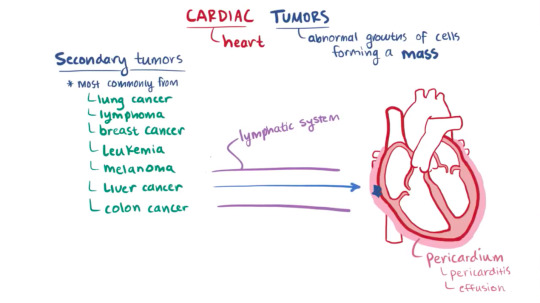
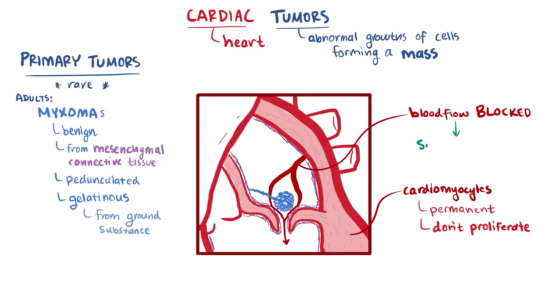
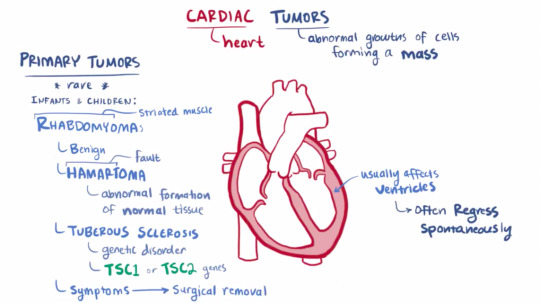
Osmosis - 心脏肿瘤:粘液瘤、横纹肌瘤
Abnormal growth of cells 细胞异常增生
form a mass in heart 于心脏中形成团块
Metastasis 转移
secondary 继发性的 vast majority of tumors of heart - tumor dvlpd smwrelse in body, metastasizd, spread2 heart, ex Lung cancer, Lymphoma,Breast cancer, Leukemia, Melanoma, Liver cancer, Colon cancer
Lymphoma 淋巴瘤
Melanoma, skin cancer 黑色素瘤
Hepatocellular carcinoma, liver cancer 肝细胞癌症,肝癌
Pericardium 心包
Pericarditis 心包炎
Pericardial effusion 心包积液
Myocardium 心肌
Primary cardiac tumors 原发性心脏肿瘤,extrmly rare
Myxoma 粘液瘤 benign tumors from Mesenchymal connective tissue 间充质结缔组织 in heart, not cardiomyocytes
Cardiomyocyte 心肌细胞 in adults, heart fully dvlpd - permanent cells not proliferate 不增殖的永久性细胞
pedunculated 带蒂的 attachd2 peduncle 肉茎 stalk of tissue
gelatinous 胶状的 as a result of abundant ground substance on histology
Mitral valve 二尖瓣 - can be near myxoma [block blood from left atrium to left ventricle ==> syncopal episodes 晕厥发作]
Rhabdomyoma 横纹肌瘤 common primary cardiac tumor in infants & children - benign tumors of heart uxly affectg ventricles, best considerd hamartomas, not true neoplasm - common in tuberous sclerosis pts - uxly regress spontaneously - surgically removed if blockg valves & bloodflow
Rhabdomyo 横纹肌 striated muscle tissue - cardiac muscle tissue
Hamartoma 错构瘤 - hamart means fault - result of abnormal formaxtion of normal tissue - some fault in how tissue grew
Tuberous sclerosis 结节性硬化症 genetic disorder csg non-cancerous masses form in various tissues <== mutation of TSC1\TSC2 tumor suppressor genes
Suppressor genes 抑癌基因 genes suppress tumor grow - mutation ==> myocyte overgrowth
regress 消退
22 notes
·
View notes
Photo

Due to the popularity of the masterpost I made for my A&P I notes, I’m making a masterpost for my A&P II notes. I’ll also make a masterpost of all my A&P notes for I & II for next Saturday.
Chapter 18 | The Endocrine System
Chapter 19 | The Cardiovascular System: The Blood
Chapter 20 | The Cardiovascular System: The Heart
Chapter 21 | The Cardiovascular System: Blood Vessels and Hemodynamics
Chapter 22 | The Lymphatic System and Immunity
Chapter 23 | The Respiratory System
Chapter 24 | The Digestive System
Chapter 25 | Metabolism and Nutrition
Chapter 26 | The Urinary System
Chapter 27 | Fluid, Electrolyte, and Acid–Base Homeostasis
Chapter 28 | The Reproductive Systems
Chapter 29 | Development
155 notes
·
View notes
Photo
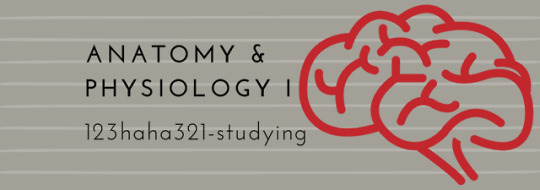
Hello everyone! Since I have finished uploading all my notes from Anatomy & Physiology I, I decided to make a masterpost for the files.
Chapter 1| An Introduction to the Human Body
Chapter 2| The Chemical Organization (Biomolecules)
Chapter 3| The Cellular Level of Organization
Chapter 4| Tissue: The Living Fabric
Chapter 5| The Integumentary System
Chapter 6| Bones & Skeletal Tissues
Chapter 7| The Skeletal System: The Axial Skeleton
Chapter 8| The Skeletal System: The Appendicular Skeleton
Chapter 9| Joints
Chapter 10| Muscular Tissue
Chapter 11| The Muscular System
Chapter 12| Nervous Tissue
Chapter 13| The Spinal Cord and Spinal Nerves
Chapter 14| The Brain and Cranial Nerves
Chapter 15| Autonomic Nervous System
Chapter 16| Sensory, Motor, and Integrative Systems
Chapter 17| Special Senses
1K notes
·
View notes
Text

Functionl anatomy 🤙🏽 Respiratory system
1 note
·
View note
Link
29 notes
·
View notes
Text
Normal Complete Blood Count Values
– also called CBC
– Hbg (hemoglobin) – men = 13 to 18 g/dL – women = 12 to 16 g/dL
– WBC (white blood cell count) – 5,000 to 11,000 /ccm
– Hct (hematocrit) – men = 37 to 49% – women = 36 to 46%
– platelets – 150,000 to 400,000 /ml
10 notes
·
View notes
Text
Heart
cpsof cardiac muscle, support 2 diff circulax [pulmonary circulax, systemic circulax]
each side of heart cssof 1 atrium [separtd from ventricles by atrioventricular valves (tricuspid on right, mitral/bicuspid on left)] & 1 ventricle [separtd from vasculature 脉��系统 by semilunar valves (pulmonary on right, aortic on left)]
pathway of blood [right atrium, tricuspid valve >> right ventricle, pulmonary valve >> pulmonary artery >> lungs >> pulmonary veins >> left atrium, mitral valve >> left ventricle, aortic valve >> aorta >> arteries >> arterioles >> capillaries >> venules >> veins >> venae cavae >> right atrium]
left heart contains more muscle than right <== systemic circulax hv much highr resistance & pressure
Electrical conducx of heart start at sinoatrial [SA] node >> atrioventricular [AV] node >> bundle of His >> travel thru Purkinje fibers
Systole [period during ventriculr contracx wn AV valves closd] & Diastole [heart relaxd, semilunar valves closd]
Cardiac output [product of Heart rate & Stroke volume]
Sympathetic nervous system ++ heart rate & contractlty
Parasympathetic nervous system – heart rate
12 notes
·
View notes
Text
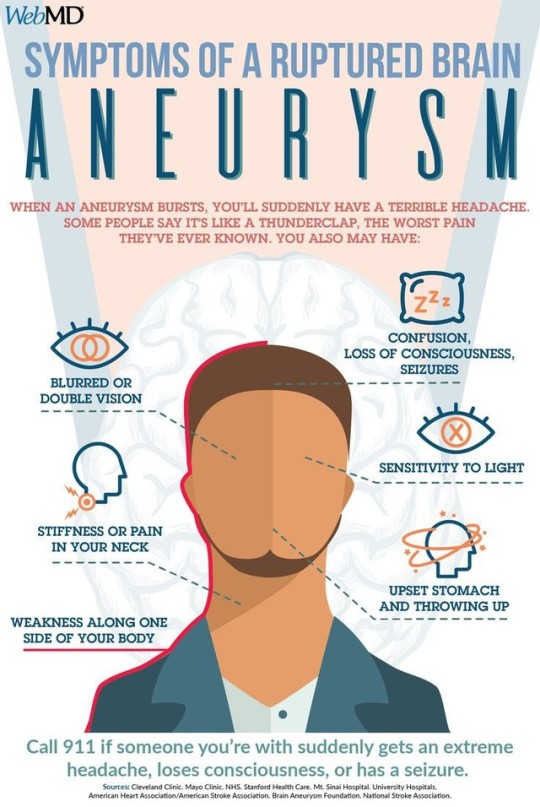
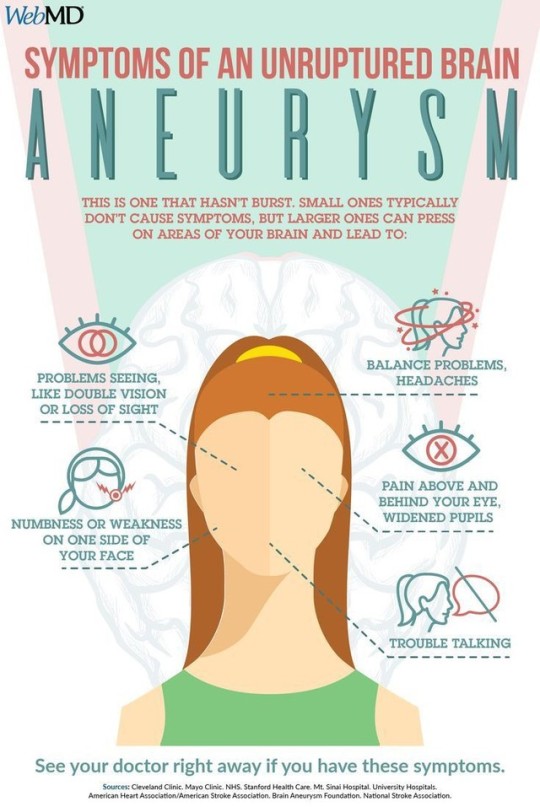
Are you aware of the signs for both a ruptured and unruptured aneurysm?
194 notes
·
View notes
Text
FREE MEDICAL PDFs
Anatomy:
1–> KLM for Gross Anatomy
2–> Snell’s Anatomy
3–> BD Churassia
4–> RJ Last
5–> Grey’s Anatomy
6–> Langman Embryology
7–> KLM for Embryology
8–> BD For General Anatomy
9–> Dissector
10–> Di Fore Histology
11–> Junqueira’s Histology
12–> Netter Atlas of human Aantomy
Folder link–> https://drive.google.com/open?id=0B3WdpdsqpX0LYV9KQ3lxY29FY28
Physiology:
1–> Guyton
2–> Ganong
3–> Sheerwood
4–> Sembulingam
Folder link–> https://drive.google.com/open?id=0B3WdpdsqpX0LdXlCSjdZM214dEE
Biochemistry:
1–> Harper
2–> Lippincott
3–> Chatterjea
4–> Satyanarayan
5–> Stryer
6–> MRS Biochemistry
Folder link–> https://drive.google.com/open?id=0B3WdpdsqpX0Ld0o3WnhCR2VEczg
Pathology:
1–> Big Robins
2–> Medium Robins
3–> Pathoma
4–> Goljan
5–> Harsh Mohan Pathology
6–> Atlas of Histopathology
7–> Levinson
8–> MRS microbiology
9–> Microbiology by Jacquelyn G. Black
10–> Color Atlas of Microbiology
11–> Kaplan Pathology
Folder link–> https://drive.google.com/open?id=0B3WdpdsqpX0LYkRYdjFrTm5MR0U
Pharmacology:
1–> Big Katzung
2–> Mini Katzung
3–> Kaplan Review
4–> Lippincott
5–> Pocket Katzung
6–> Rang and Dale’s Pharmacology
7–> Atlas of Pharmacology
Folder link–> https://drive.google.com/open?id=0B3WdpdsqpX0LMkE1UUVRZGwtTlU
Forensic Medicine:
1–> Simpson’s Forensics
2–> Krishan’s Forensics
3–> Atlas of Autopsy
4–> Atlas of Forensic Medicine
Folder link–> https://drive.google.com/open?id=0B3WdpdsqpX0LQXVwOGoyWnFSV2s
Ophthalmology:
1–> Jogi
2–> Jatoi
3–> Parson’s Textbook of Eye
4–> Kanski
5–> AK Khurana
6–> Atlas of ophthalmology
Folder link–> https://drive.google.com/open?id=0B3WdpdsqpX0LOHc5WVZMdkJjX2M
Otorhinolaryngology:
1–> Dhingra
2–> Logans Turner
3–> Color Atlas of Otorhinolaryngology
4–> Maqbool’s Text Book of ENT
5–> Clinical Methods in ENT by PT Wakode
6–> ENT at a Glance
Folder link–> https://drive.google.com/open?id=0B3WdpdsqpX0LaDY2a0lFNDlfTGc
Community Medicine:
1–> Monica’s Text Book Community Medicine
2–> Mahajan And Gupta Text Book of Community Medicine
3–> Bancroft’s Text Book of Community Medicine
Folder link–> https://drive.google.com/open?id=0B3WdpdsqpX0Lc1RCMml2NjhFNjA
Internal Medicine:
1–> Churchill’s Pocketbook of DD
2–> MTB Step 2 Ck
3–> Davidson Essentials
4–> Davidson Principals and practice
5–> Harrison’s Internal Medicine
6–> Internal Medicine USMLE Nuggets
7–> Internal Medicine on call bt LANGE 8–> Oxfords Specialties
Folder link–>https://drive.google.com/open?id=0B3WdpdsqpX0LeEFJNG5TMlc4eWc
Surgery:
1–> Bailey_love short practice of Surgery
2–> Churchill’s pocketbook of Surgery
3–> Deja Review of surgery
4–> Farquharson’s Textbook of Operative General Surgery
5–> Hamilton Bailey’s Physical Signs
6–> Oxford Handbook of Clinical Surgery
7–> Schwartz’s Principles of Surgery
8–> Macleod’s Clinical Examination
9–> Macleod’s Clinical Diagnosis
Folder link–>https://drive.google.com/open?id=0B3WdpdsqpX0LRFpFSG5hZ1pVWkE
Obstetrics & Gynecology:
1–> Case Discussions in Obstetrics and Gynecology
2–> Deja Review of Obstetrics Gynecology
3–> Obstetrics by Ten Teachers
4–> Gynaecology illustrated
5–> Gynaecology by Ten Teachers
Folder link–>https://drive.google.com/open?id=0B3WdpdsqpX0LMU1LRjFDa1FrbjA
Pediatrics:
1–> Nelson Essentials of Pediatrics
2–> Nelson Complete
3–> Pediatrics Review
Folder link–>https://drive.google.com/open?id=0B3WdpdsqpX0LUkdTQkVuNV92Yzg
I hope this helps everyone, it’s not mine. But has been shared to me and I am sharing this with all of you.
11K notes
·
View notes

